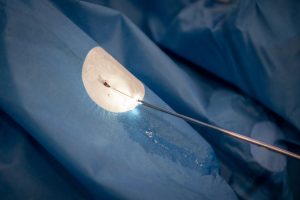Who is suitable for ureteroscopy and kidney stone laser surgery?
What are the advantages of ureteroscopy and laser stone surgery?
How is ureteroscopy and laser stone surgery performed?
What to expect after ureteroscopy and laser stone surgery?
Procedure outcomes
Post-Operative Care Instructions
Ureteroscopy is a minimally-invasive procedure that allows for the detection and correction of problems in the upper urinary tract. It is commonly performed in patients that have kidney stones or stones in the ureter. Ureteroscopy is often performed to enable laser stone surgery, in order to break up the kidney stones and allow them to pass safely.
Doctors Shekib Shahbaz and Tony De Sousa of Melbourne Urology Centre are experts in performing laser stone surgery. They use a start-of-the-art high powered holmium laser and the new ‘Moses’ technology, which allows them to perform very safe, fast and effective stone fragmentation.
Kidney stone fragment suspended in the basket of the ureteroscope

Who is suitable for ureteroscopy and kidney stone laser surgery?
- Those experiencing symptoms related to kidney stones including
- Back or flank pain
- Sweating and nausea
- Blood in the urine
- Those who have tried other non-surgical treatments that have not worked
- Those who have kidney stones that are too large to pass without intervention.
- Stones less than 1.5cm in size
What are the advantages of ureteroscopy and laser stone surgery?
- No skin incisions are required
- Ureteroscopy gives the surgeon a very clear view of the urinary tract
- Moses technology allows for virtually any stone type to be broken
- Shorter hospital stay and faster recovery, compared to traditional kidney stone surgery (PCNL). PCNL is generally reserved for patients with a larger stone burden
How is ureteroscopy and laser stone surgery performed?
- The procedure is performed under general anaesthetic and may take up to an hour to complete
- A small telescopic instrument (ureteroscope) is passed into the urethra and bladder, then into the ureter and kidney
- The stone is located and the holmium laser combined with Moses technology are used to break it up
- Larger stone fragments may need to be removed by the surgeon whilst smaller, sand-like fragments remain to be gradually passed through the urine
- In some cases, a temporary stent is placed in the ureter in order to keep it open and help any remaining stone fragments to pass
What to expect after ureteroscopy and laser stone surgery?
- The recovery is done at home, with normal light activities able to resume as soon as the next day
- If you have a stent in place, you will need to return to have it removed after a week or so
- During this time it is not uncommon to see some blood in the urine in the days following the procedure. You may also feel the urge to urinate frequently
- It is important to drink plenty of water to help with flushing the stone fragments out through the urine
Procedure outcomes
- Most patients will still have some discomfort in the flank area or bladder for a few days following the procedure
- Moses technology and high-powered holmium laser allows the large majority of patients to be treated with one procedure
Post-Operative Care Instructions
What to expect:
- Discomfort in the abdomen and flank on the side of the procedure is common. If you have a temporary stent in place, the discomfort may persist until it is removed. The pain may be worse when urinating, as the urine refluxes up the stent into the kidney; this is not dangerous. Try to avoid straining when passing urine
- Blood in the urine is common following surgery; it may be intermittent, and it may last as long as the stent is in place. The extent can vary based on your level of activity and hydration. It usually resolves within a few days of the stent being removed
- Urinary frequency and urgency as well as nocturia (urinating at night time) is common wile the stent is in place. Often you will have a strong urge to pass only a small amount of urine. This is because the stent irritates the lining of the bladder, so symptoms usually resolve within a few days of the stent being removed
- Burning and stinging with urination is common following surgery and may last for as long as the stent is in place. This does not usually indicate infection unless fever is present.
Return to activity:
- Driving – no driving for 24 hours following surgery. You may need to refrain for driving longer, if you have been prescribed strong pain medications
- Work – you will require some time off work; the duration will depend on your occupation. You will typically need 1-2 days off work
- Lifting – may exacerbate symptoms and bleeding due to the presence of the ureteric stent, however there are no restrictions unless your doctor advises otherwise
- Activities – you may participate in your normal activities (including running, swimming, gym, golf, cycling etc) within your comfort levels. Be mindful that physical activity may exacerbate some symptoms such as blood in the urine
- Sex – no restrictions unless your doctor advises you otherwise.
Medication and Pain Management:
- Your doctor may prescribe medication if you have severe urinary symptoms (frequency, urgency or nocturia) due to the stent being present
- You may take paracetamol or ibuprofen for pain and discomfort. If your pain is unmanageable with over the counter medications, your doctor may prescribe stronger pain relief medication
- You may take Ural (available over the counter at the chemist) to relieve burning and stinging with urination.
FAQ:
How long will the stent need to stay in place?
Depending on the surgery, the ureteric stent will need to remain in place for 2-4 weeks.
Head directly to your nearest hospital emergency room if:
- You are unable to urinate
- Fevers, chills or shakes (may indicate infection).
Follow-Up Information:
Our rooms will contact you to arrange a follow-up appointment with your urologist. Your urologist will often arrange a follow up scan, typically several months after the procedure
Your follow-up appointment is on: ____________________ at __________________.
Please note that whilst a ureteric stent is usually a necessary part of a minimally invasive stone or ureteric surgery, this must be removed after the treatment is completed. If you have any concerns about the timing of your stent removal, please contact our rooms for clarification.
Contact Information:
If you have any questions or concerns that are not addressed here or in the procedure information available on our website melbourneurologycentre.com.au contact our rooms on 1300 702 811 or [email protected]
Post-Operative information for this procedure can be found here: Ureteroscopy & Stent Post-Operative Care Instructions
Written by Dr. Shekib Shahbaz and Dr. Tony de Sousa
Reeves, T., Pietropaolo, A., Somani, B.K., (2020), Ureteroscopy and laser stone fragmentation is safe and tends to improve renal function in patients with chronic kidney disease: Prospective outcomes with a minimum follow-up of 6 months, journal of Endourology, 34(4), [https://pubmed.ncbi.nlm.nih.gov/31891664/], accessed 25/02/21.
